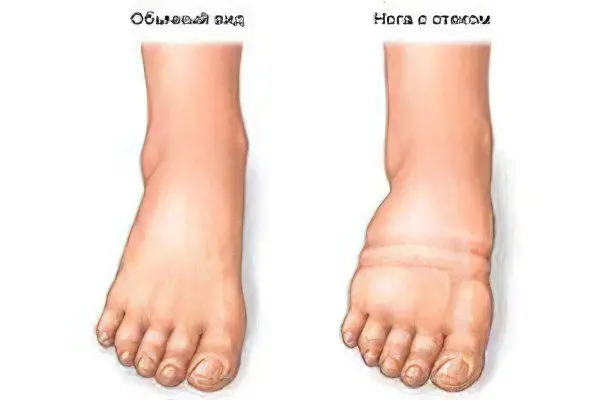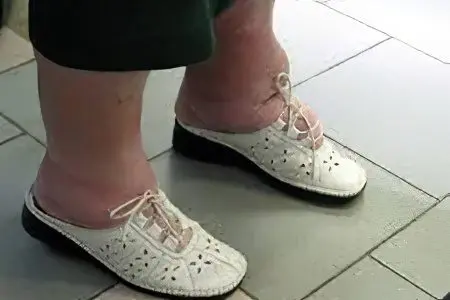Contents
What is leg swelling?

Edema of the legs is an overflow of cells and intercellular space of the muscle tissues of the legs with liquid. Such pathological changes are most often exposed to the distal segments of the lower extremities – lower legs and feet. This phenomenon is associated with the highest functional load, which is performed by the feet and legs of a person in the process of life, and their lowest position in relation to the central parts of the body when in a vertical position.
All fluid in the body is located in the vascular and intercellular spaces. The possibility and degree of edema increase depends on the balance between them.
In this self-regulating mechanism, the key links belong to:
Hydrostatic pressure of blood on the vascular wall;
Hydrodynamic characteristics of blood flow;
Indicators of osmotic and oncotic activity of plasma and intercellular space.
Symptoms of severe swelling of the legs
It is possible to understand and suspect the presence of swelling of the legs on the basis of certain symptoms. They can have varying degrees of severity, and at the same time they are able to remain at a stable level or progress. In the first case, they talk about the physiological mechanisms of the appearance of edematous syndrome. In the second – definitely about the pathology. Therefore, considering such issues, one cannot ignore any manifestations of edema that may indicate a dangerous disease.
Alarming symptoms include:

pasty. It is a diffuse light impregnation of the skin and subcutaneous tissue of the legs in the lower third and the area of the ankle joint around the entire circumference on both limbs. Its presence is evidenced by light traces remaining after strong pressure on the skin of the anterior surface of the lower leg in the projection of the tibia. The same diagnostic value belongs to traces of socks;
Local swelling. As a rule, it is located on one or two limbs in the ankle area or around the circumference of the ankle joint;
Severe swelling of one or both legs or feet. At the same time, it extends to the level of the knee joint or even higher. After pressing on the skin, a large depression remains, which does not straighten out for a long time;
Trophic disorders of the skin due to edema. Occur only with severe edema, causing overstretching of the skin. Against this background, an increased outflow of fluid from the surface of the skin develops and cracks appear, which transform into erosion, wounds, trophic ulcers and dermatitis.
Causes of swelling of the legs
Edema of the legs is not a separate disease, but a symptom that must be correctly interpreted in relation to determining the possible cause of its occurrence. There are several groups of diseases manifested by swelling of the legs. All these diseases and the main differential diagnostic criteria are given in the table:
Group of causative diseases | What does edema look like |
Edema of the legs in healthy people, caused by overload of the lower extremities and hydrostatic effect on the vessels of the microcirculatory bed against the background of a long stay in an upright position. | Both legs and feet swell to the same extent. Edema is represented by pastosity in the lower third around the entire circumference of the legs. Appears in the evening after standing or physically hard work. After rest, such edema disappears. |
Swelling of the legs as a sign of heart failure | In diseases of the heart, accompanied by circulatory failure, there is a constant stagnation in the veins. This is manifested by edema of different density and prevalence: from mild and insignificant in the initial stages, to dense and widespread up to the knee joint during decompensation. Both limbs swell. In the morning, the swelling may decrease slightly. |
Edema of the legs in renal pathologies | The shins and feet swell most of all with nephritic syndrome and severe renal failure. Mandatory the same expression on both limbs. Unlike cardiac edema, these edema are more pronounced in the morning, and decrease in the evening. Puffiness of the face is more characteristic than the lower extremities. |
Edema of the legs in diseases of the venous system of the extremities (varicose veins, thrombophlebitis, post-thrombophlebitic syndrome) | Edema is necessarily unilateral, and if bilateral, then with a primary lesion of one of the legs. Such edema is very persistent and dense. Sharply increase after staying in an upright position, especially motionless. The edema of the ankle region is most pronounced. After staying in a horizontal position, the swelling decreases. |
Edema of the legs in diseases of the lymphatic system of the extremities (erysipelas and its consequences, lymphovenous insufficiency, lymphedema) | Like venous, edema is located mainly on one side. Differ especially in high density and firmness. Rarely decrease from any manipulation and action. A characteristic manifestation of edema of lymphatic origin is localization on the dorsum of the foot in the form of a pillow. |
Edema of the legs in the pathology of the musculoskeletal system | Almost always unilateral, limited, localized in the area of the affected joint or bone, accompanied by pain and dysfunction of support and walking. |
Edema of the legs with inflammatory and purulent-infiltrative diseases of the skin and soft tissues, with injuries of the limbs | The swelling is limited. Expression may vary. With bites and injuries, edema spreads around the focus. With deep abscesses, the entire affected segment increases in volume. For fractures, local swelling at the site of the fracture is more typical, for torn ligaments and sprains – a common edema of the type of hematoma. |
Other causes of leg swelling:
| The edema is soft, uniform, located on both limbs. The exception is cases of diseases of the nervous system, accompanied by unilateral paralysis. In such a situation, edema is localized on the affected limb. These edemas are relatively stable throughout the day, but may increase in the evening. They do not reach great severity, except in cases of decompensation of diseases and aggravation of the general condition, due to the addition of other causes of increased swelling. |
How to remove swelling from the legs?

Treatment of edema of the legs is not always the right and grateful thing. After all, the elimination of a symptom cannot save a person from the disease. Therefore, it is more correct to treat not edema, but the disease that led to their appearance. The exception is cases of hydrostatic edema in healthy people against the background of overexertion of the legs.
Differentiated treatment tactics for edema of the legs can be as follows:
Hydrostatic edema in persons without pathology:
Limitation of physical activity on the legs;
Periodic unloading for the calf muscles in the form of their elevated position, gymnastics and massage;
The use of compression stockings (stockings, stockings, tights), which help to retain fluid in the vascular space by compressing soft tissues;
Specialized measures are not required due to the physiological origin of edema. It is acceptable to use ointments and gels described in the section “treatment of edema of venous origin”.
Cardiac and renal edema:
Diuretics. Various loop (furosemide, lasix, trifas), thiazide (indapamide, hypothiazide) and potassium-sparing (veroshpiron, spironolactone) diuretics are used. The frequency of administration, dosage form and duration of treatment depend on the degree of heart failure. Severe edema is treated with injectable loop diuretics with a gradual transition to tablet intake of identical drugs or drugs from another group. For long-term decongestant therapy, thiazide diuretics are best suited in combination with veroshpiron;
Potassium preparations (panangin, asparkam). Necessarily are part of drug therapy with loop diuretics. This is necessary in order to compensate for the loss of potassium ions, which are excreted in the urine when diuresis is stimulated. But such drugs are contraindicated in renal failure.
Cardioprotective agents. They do not have a direct anti-edematous effect, but strengthen the heart muscle, the weakness of which causes heart failure and swelling of the legs.
Edema of venous origin:
Compression of the legs and feet with elastic bandages or special knitwear. This event should be the first in the complex treatment of edematous syndrome, since it not only helps in the fight against swelling of the legs, but is a really good method for preventing the progression of venous insufficiency. The main thing is to follow all the rules of elastic bandaging;
Phlebotonics (escusan, troxevasin, detralex, normoven). The mechanism of the anti-edematous action of drugs in this group is to strengthen the walls of the veins and vessels of the microvasculature. Phlebotonics of plant origin (escusan) can also be prescribed in the absence of obvious signs of varicose veins, if there is a pronounced pastiness that goes beyond the usual hydrostatic edema;
Blood-thinning agents (aspekard, cardiomagnyl, lospirin, clopidogrel). The mechanism for reducing swelling of the legs is associated with a decrease in blood viscosity. If it becomes more liquid, then its outflow improves, and this prevents stagnation and sweating in the tissue in the form of edema;
Local preparations in the form of ointment and gel (lyoton gel, heparin ointment, troxevasin, hepatrombin, venohepanol, aescin, venitan). Their local application is quite effective, both in venous pathology and in edema against the background of habitual leg fatigue as a result of overstrain.
[Video] Cardiovascular surgeon, phlebologist Abasov M. M. – How to get rid of leg swelling in a week:









